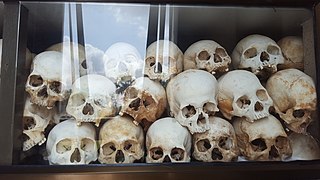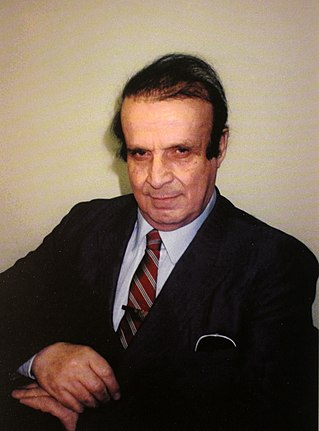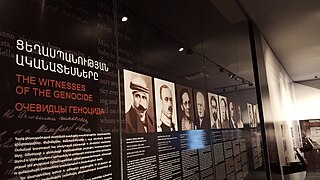
Genocide is violence that targets individuals because of their membership of a group and aims at the destruction of a people.

Vahakn Norair Dadrian was an Armenian-American sociologist and historian, born in Turkey, professor of sociology, historian, and an expert on the Armenian genocide.

Aram Andonian was an Armenian journalist, historian and writer.

The Istanbul trials of 1919–1920 were courts-martial of the Ottoman Empire that occurred soon after the Armistice of Mudros, in the aftermath of World War I.
Impunity is the ability to act with exemption from punishments, losses, or other negative consequences. In the international law of human rights, impunity is failure to bring perpetrators of human rights violations to justice and, as such, itself constitutes a denial of the victims' right to justice and redress. Impunity is especially common in countries which lack the tradition of rule of law, or suffer from pervasive corruption, or contain entrenched systems of patronage, or where the judiciary is weak or members of the security forces are protected by special jurisdictions or immunities. Impunity is sometimes considered a form of denialism of historical crimes.

The Memoirs of Naim Bey: Turkish Official Documents Relating to the Deportation and the Massacres of Armenians, containing the Talat Pasha telegrams, is a book published by historian and journalist Aram Andonian in 1919. Originally redacted in Armenian, it was popularized worldwide through the English edition published by Hodder & Stoughton of London. It includes several documents (telegrams) that constitute evidence that the Armenian genocide was formally implemented as Ottoman Empire policy.
Edward J. Erickson is a retired regular U.S. Army officer at the Marine Corps University who has written widely on the Ottoman Army during World War I. He is an associate of International Research Associates, Seattle, Washington and as of July 2016 was also listed as an advisory board member of the Ankara-based, Turkish government aligned think-tank, Avrasya Incelemeleri Merkezi (AVIM), which goes by the English name Center for Eurasian Studies.
Samuel Totten is an American professor of history noted for his scholarship on genocide. Totten was a distinguished professor at the University of Arkansas, Fayetteville where he taught from 1987 to 2012 and served as the chief editor of the journal Genocide Studies and Prevention. He is a Member of the Council of the Institute on the Holocaust and Genocide, Jerusalem.

Trebizond was a city in the Ottoman Empire where the Armenian genocide occurred. The method employed to kill was mainly by mass drowning, resulting in estimated deaths of 50,000 Armenians. The city was also an important location of subsequent trials held to prosecute those involved with the systematic massacre. Cemal Azmi, the governor of Trebizond during the genocide, was later assassinated as part of Operation Nemesis.
The genocide of indigenous peoples, colonial genocide, or settler genocide is the elimination of indigenous peoples as a part of the process of colonialism.

Witnesses and testimony provide an important and valuable insight into the events which occurred both during and after the Armenian genocide. The Armenian genocide was prepared and carried out by the Ottoman government in 1915 as well as in the following years. As a result of the genocide, as many as 1.5 million Armenians who were living in their ancestral homeland were deported and murdered.
Cherkes Ahmet was the leader of the Ottoman Empire's state-sponsored paramilitary marauders of supposedly Circassian origin during World War I. Cherkes Ahmet was from Serres, Macedonia. He was notoriously responsible for the murder of the well-known Armenian writer, literary critic and politician Krikor Zohrab and politician Vartkes Serengülian during the Armenian genocide. Ahmet supported the Committee of Union and Progress during the coup d'état of January 1913 following which he became a leading member of the Special Organization in Van, where he was given the responsibility of subduing the Armenian population by Cevdet Bey, the Governor of Van at the time. Ahmet, along with fellow murderers Halil and Nazim, were tried and executed in Damascus by Djemal Pasha in September 1915. The assassinations became the subject of a 1916 investigation by the Ottoman Parliament led by Artin Boshgezenian, the deputy for Aleppo.

During the Armenian genocide, which occurred in the Ottoman Empire, led at the time by the Young Turks, the Turkish armed forces, militias, and members of the public engaged in a systematic campaign of genocidal rape against female Armenians and children of both sexes. Before the genocide had begun, one method used to intimidate the Armenian population was sexual humiliation. Women and young girls were not only subjected to rape, but also forced marriage, torture, forced prostitution, slavery and sexual mutilation.

Hafız Mehmet was a Turkish politician and the acting Minister of Justice for the Republic of Turkey. While serving as a deputy in Trabzon, he was a witness to the Armenian genocide. His testimony of the event is considered by genocide scholar Vahakn Dadrian as one of the "rarest corroborations of the fact of the complicity of governmental officials in the organization of the mass murder of Armenians". He was sentenced to death after the Izmir trials of 1926, charged with attempting to assassinate Mustafa Kemal Atatürk.
At the conclusion of his Obersalzberg Speech on 22 August 1939, a week before the German invasion of Poland, Nazi leader Adolf Hitler reportedly said "Who, after all, speaks today of the annihilation of the Armenians?".
Bibliography of the Armenian genocide is a list of books about the Armenian genocide:

The relationship between the Armenian genocide and the Holocaust has been discussed by scholars. The majority of scholars believe that there is a direct causal relationship between the Armenian genocide and the Holocaust, however, some of them do not believe that there is a direct causal relationship between the two genocides.
Perpetrator studies, also known as perpetrator research, is a nascent interdisciplinary, scholarly field of research into the perpetrators of mass killings and/or political violence. It is covered in Journal of Perpetrator Research and other publications.
The International Conference on the Holocaust and Genocide was the first major conference in the field of genocide studies, held in Tel Aviv on 20–24 June 1982. It was organized by Israel Charny, Elie Wiesel, Shamai Davidson, and their Institute on the Holocaust and Genocide, founded in 1979. The conference's objective was to further the understanding and prevention of all genocides; it marked the shift from viewing genocide as an irrational phenomenon to one that could be studied and understood.

Genocide is the intentional destruction of a people in whole or in part. The term was coined in 1944 by Raphael Lemkin. It is defined in Article 2 of the Convention on the Prevention and Punishment of the Crime of Genocide (CPPCG) of 1948 as "any of the following acts committed with intent to destroy, in whole or in part, a national, ethnical, racial, or religious group, as such: killing members of the group; causing serious bodily or mental harm to members of the group; deliberately inflicting on the group's conditions of life, calculated to bring about its physical destruction in whole or in part; imposing measures intended to prevent births within the group; [and] forcibly transferring children of the group to another group."











